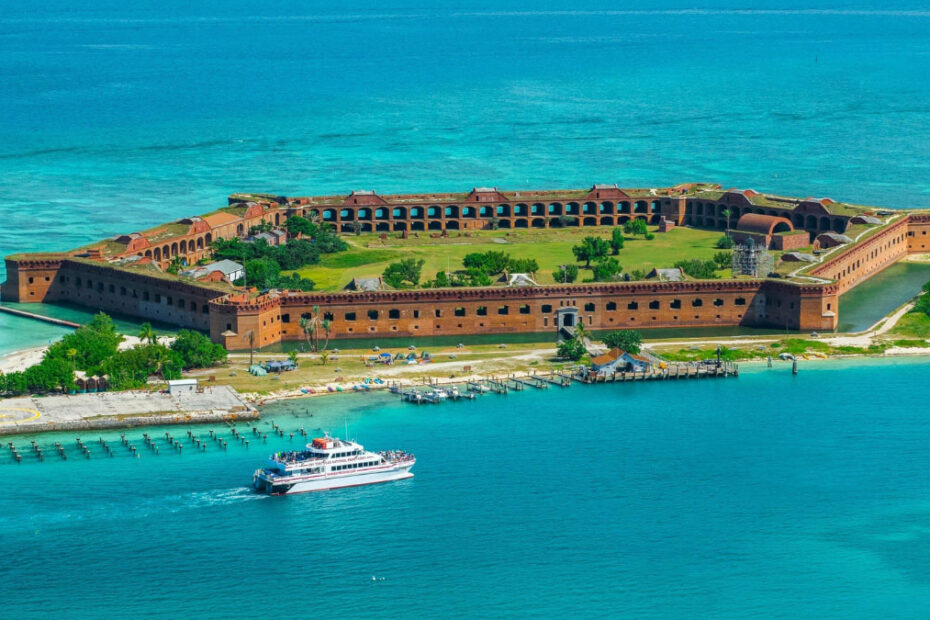Imagine stepping onto a remote island paradise where crystal-clear waters meet historic fortresses and vibrant marine life. Dry Tortugas National Park, located about 70 miles west of Key West, offers a unique blend of natural beauty and historical intrigue. Whether you’re an avid snorkeler, history buff, or just looking to escape the hustle and bustle, this hidden gem has something for everyone.
Key Takeaways
- Best Time to Visit: The dry season (November to April) offers mild weather and lower humidity, making it the ideal time for outdoor activities. The wet season (May to October) is less crowded but comes with higher humidity and potential hurricanes.
- Transportation Options: Visitors can reach Dry Tortugas National Park by ferry, seaplane, or private boat. Each option offers a unique experience, ranging from guided tours to breathtaking aerial views.
- Top Activities: Must-do activities include exploring Fort Jefferson, snorkeling and swimming in crystal-clear waters, bird watching, and camping for an immersive experience.
- Unique Experiences: Don’t miss out on visiting Loggerhead Key, walking the moat wall of Fort Jefferson, and taking part in wildlife viewing, especially during bird migration seasons.
- Essential Tips: Plan ahead by making reservations for transportation and camping, bring ample supplies including water and snacks, and follow “Leave No Trace” principles to minimize your impact on the environment.
Best Time to Visit Dry Tortugas National Park
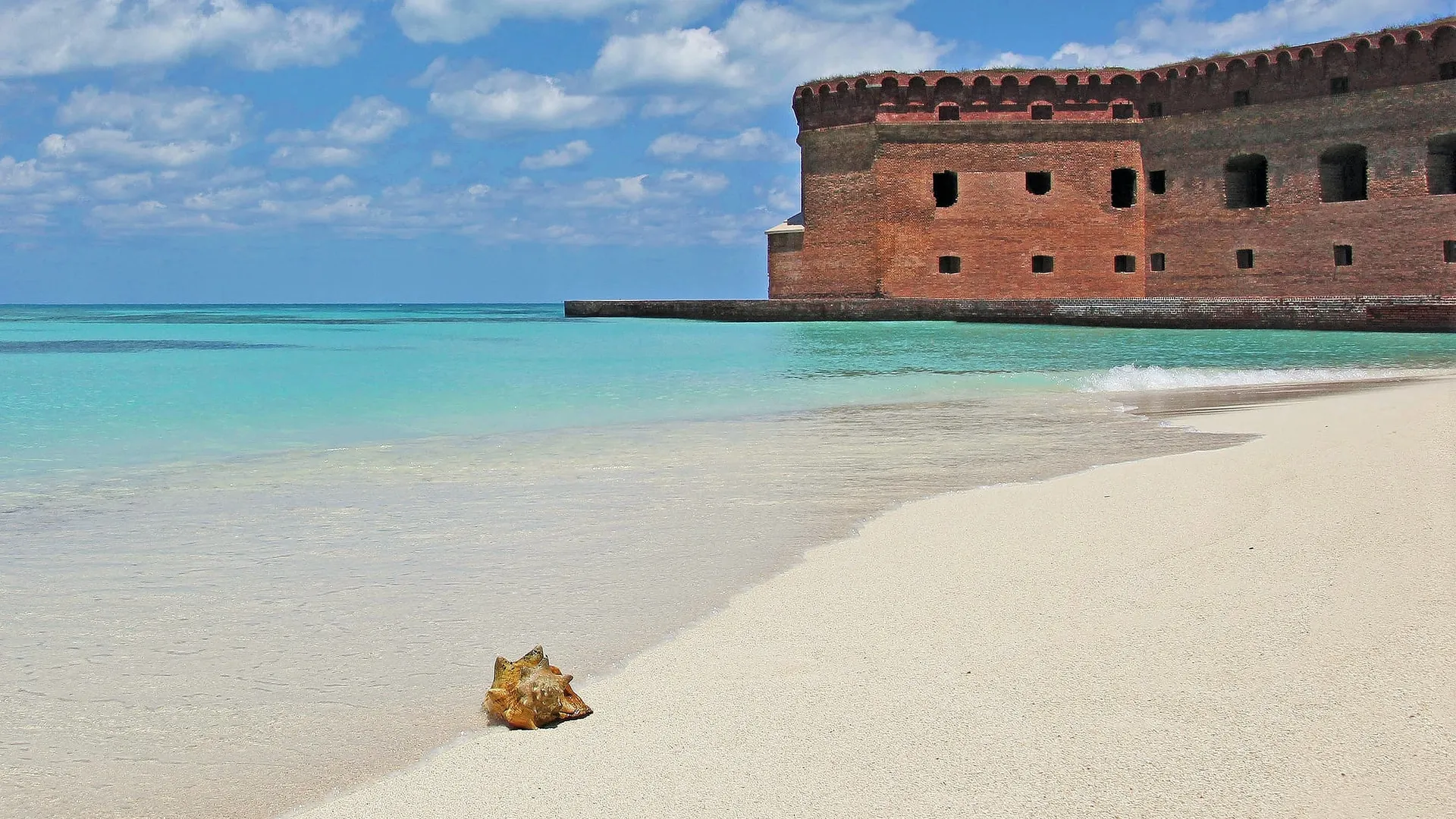
The best time to visit Dry Tortugas National Park depends largely on your preferences for weather and crowd levels. Understanding the seasonal variations is key to planning a perfect trip.

Weather and Climate
Dry Tortugas National Park experiences a tropical savanna climate, characterized by warm temperatures year-round and distinct wet and dry seasons.
| Season | Months | Weather Characteristics | Average Temperature |
|---|---|---|---|
| Dry Season | November-April | Mild, low humidity, minimal rainfall | 65-80°F (18-27°C) |
| Wet Season | May-October | Hot, humid, frequent rain showers, possible hurricanes | 75-90°F (24-32°C) |
Peak Season
The dry season, from November to April, is the most popular time to visit. During these months, you can experience mild weather and lower chances of rain. This period is ideal for outdoor activities like snorkeling, swimming, and exploring Fort Jefferson. But, it’s also the peak tourist season, so expect larger crowds and book your camping site or day trip ferry tickets in advance.
Off-Peak Season
Visiting during the wet season, from May to October, offers a more secluded experience. Though you might encounter rain showers and higher humidity, the park is less crowded. This season is perfect for those who prefer a quieter trip and enjoy the lush greenery brought by the rain. Keep in mind that hurricanes can occur, so it’s essential to monitor weather forecasts and have a flexible travel plan.
Events and Festivals
Consider planning your visit around special events or ranger-led programs for a unique experience. Historical reenactments, bird-watching tours, and night sky programs add an extra dimension to your visit. Check the park’s official calendar for upcoming events.
Sustainability Tips
To minimize impact on this delicate environment, follow Leave No Trace principles. Pack out all trash, respect wildlife, and use reef-safe sunscreen. Sustainable travel practices help preserve the park’s beauty for future visitors.
By considering these factors, you can choose the best time to visit Dry Tortugas National Park, ensuring a memorable and enjoyable experience.
How to Get to Dry Tortugas National Park
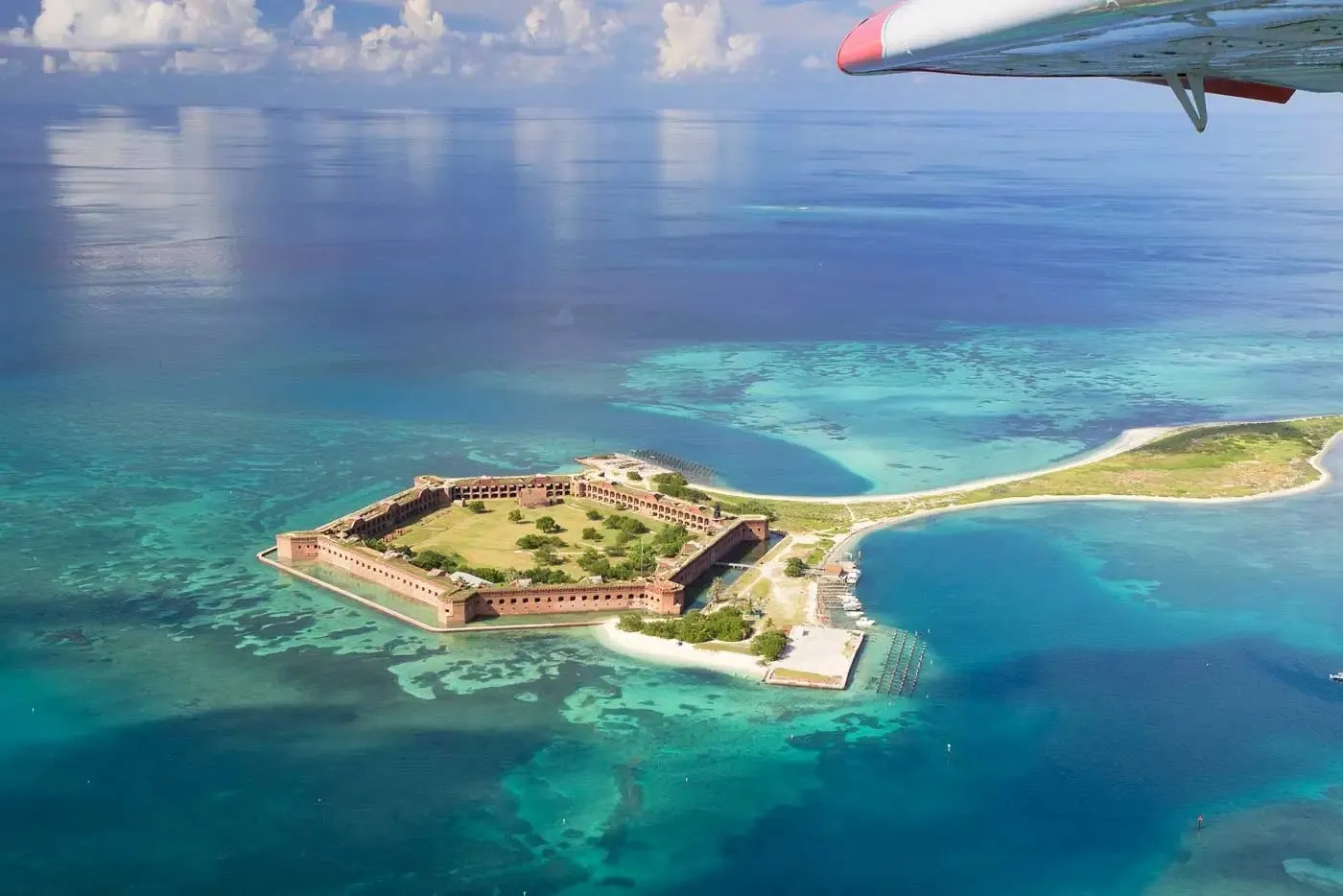
Dry Tortugas National Park, located 70 miles west of Key West, requires some planning to reach, but the options available provide unique and memorable experiences.
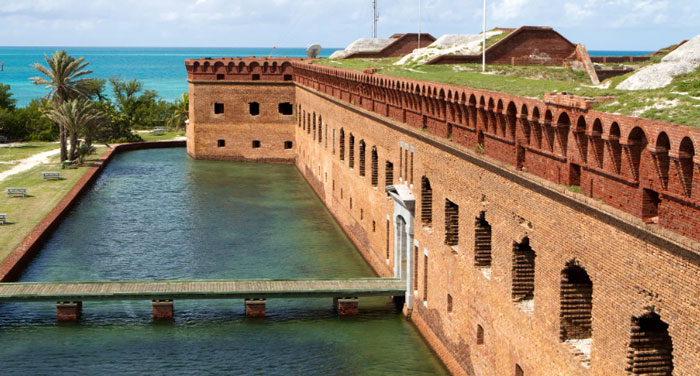
Ferry
The Yankee Freedom III ferry is the primary mode of transport for most visitors. This high-speed catamaran offers a comfortable ride, taking approximately 2.5 hours each way. Departure is from Key West with a check-in time at 7:00 AM and return by 5:15 PM. The ferry ticket includes breakfast, lunch, and a guided tour of Fort Jefferson. Reservations are highly recommended due to the ferry’s popularity.
Seaplane
For a more adventurous trip, the Dry Tortugas Seaplane offers a breathtaking 40-minute flight from Key West. You get an aerial view of the turquoise waters and coral reefs surrounding the park. Two options are available: a half-day trip with around 2.5 hours in the park, or a full-day trip with six and a half hours. The seaplane provides snorkeling gear, and pilots often share insightful information about the area’s natural and historical significance.
Private Boat or Charter
Experienced sailors or those seeking a private getaway may opt for a private boat or charter. Permits are required, and the journey takes around four hours, depending on the vessel. Given the remote location, ensure you’re well-prepared with enough supplies, including water, food, and emergency equipment. Local charters can also arrange guided trips, offering knowledge of the best spots and ensuring safety.
Top Activities at Dry Tortugas National Park
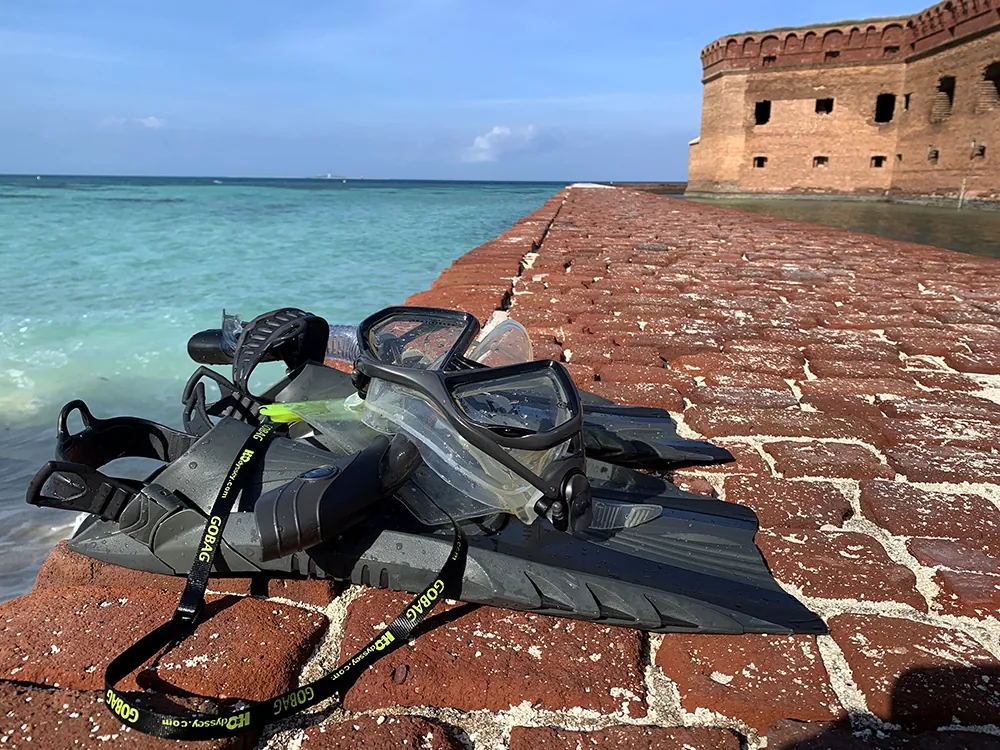
Dry Tortugas National Park offers a range of activities that showcase the area’s rich history and natural beauty. From exploring historic fortresses to enjoying vibrant marine life, there’s something for everyone.
Explore Fort Jefferson
Fort Jefferson, located on Garden Key, is the largest masonry structure in the Western Hemisphere. Constructed in the 1800s, it was designed to protect ship traffic in the Gulf of Mexico and the Straits of Florida. Even though its impressive size, the fort was never completed or attacked.
- Self-Guided Tours: Wander through the fort’s three levels at your own pace. Discover its massive brick walls, arched corridors, and picturesque canons.
- Ranger-Guided Tours: Join a ranger for a 45-minute tour to gain deeper insights into the fort’s construction, historical significance, and various roles over the years, including as a prison and coaling station.
- Panoramic Views: Climb to the top level for sweeping views of the surrounding turquoise waters and adjacent islands.
Snorkeling and Swimming
Dry Tortugas boasts excellent snorkeling and swimming opportunities. The shallow waters, typically 5-15 feet deep, are perfect for beginners and experienced snorkelers alike.
- Coral Reefs: Explore vibrant coral reefs teeming with colorful fish and other marine life.
- Underwater Shipwrecks: Discover the submerged remnants of historical shipwrecks, providing an exciting element for underwater exploration.
- Swim Beaches: Relax on white sandy beaches and take a refreshing dip in the crystal-clear waters.
Bird Watching
As a prime location on the migratory path, the park is a bird watcher’s paradise.
- Species: Spot unique species, including the sooty tern, brown noddy, and masked booby.
- Observation Points: Use designated observation points for bird watching, especially during migration seasons in spring and fall.
- Loggerhead Key: This uninhabited island offers excellent bird-watching opportunities and a tranquil natural setting.
Camping
Camping at Dry Tortugas offers a unique, immersive experience in this remote paradise.
- Garden Key Campground: The only campground in the park, located near Fort Jefferson, offers rustic camping facilities.
- Permits Required: Advance permits are necessary, and campsites are offered on a first-come, first-served basis.
- Essential Supplies: Bring all necessary supplies, including freshwater, as amenities are minimal.
Kayaking and Paddleboarding
Enjoy the park’s serene waters with kayaking and paddleboarding.
- Mangrove Areas: Paddle through mangrove areas to observe wildlife in their natural habitat.
- Accessible Bays: Explore shallow bays and inlets around the park.
- Rentals: Limited kayak and paddleboard rentals are available; consider bringing your own equipment if possible.
Accommodations
| Accommodation | Amenities | Price Range | Best For |
|---|---|---|---|
| Garden Key Camping | Rustic, near Fort Jefferson | Low | Adventurous, immersive experiences |
| Yankee Freedom III | Meals, guided tour included | Moderate | Comfortable, guided experiences |
| Seaplane Trips | Breathtaking views, snorkeling gear included | High | Unique, memorable experiences |
Dining Highlights
Due to its remote location, dining options are limited, making it essential to plan ahead.
- Pack Meals: Bring enough food and snacks for your entire trip.
- Picnic Spots: Use picnic areas around Garden Key for a scenic dining experience.
- Water Supply: Bring sufficient water, as potable water is not available on the islands.
Transportation & Practical Tips
- Yankee Freedom III Ferry: Comfortable 2.5-hour ride from Key West, includes meals and guided tours.
- Seaplane Flights: Breathtaking 40-minute flights, options for half-day or full-day trips including snorkeling gear.
- Private Boats: Experienced sailors can use private boats or charters with the necessary permits.
| Month | Avg. High Temperature (°F) | Avg. Low Temperature (°F) | Precipitation (in) |
|---|---|---|---|
| January | 75 | 64 | 2.0 |
| April | 81 | 71 | 2.6 |
| July | 88 | 80 | 3.4 |
| October | 83 | 75 | 4.2 |
For the best experience, visit during the dry season (November-April) when mild weather and lower humidity make exploring the park pleasant. Always bring essentials to preserve the park’s delicate environment and ensure a memorable trip.
Unique Experiences
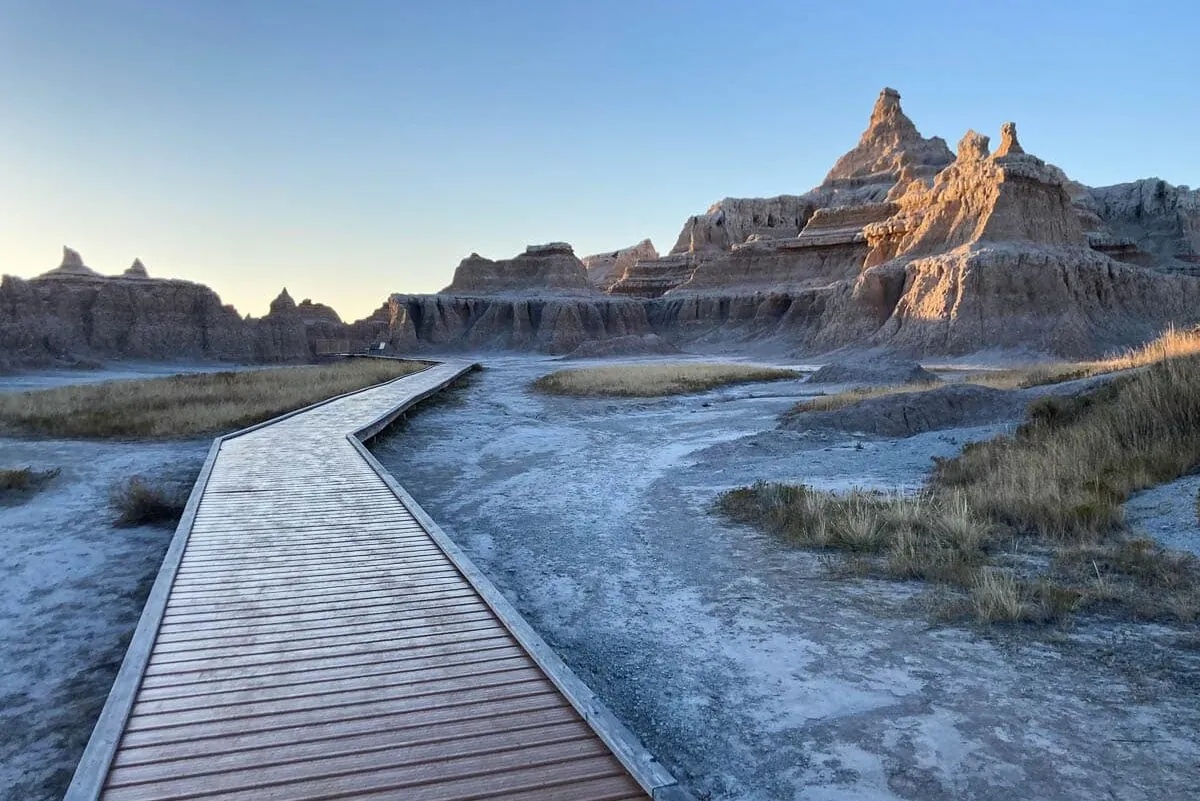
Dry Tortugas National Park offers a range of unique experiences that cater to diverse interests. From exploring secluded islands to admiring historical structures, there’s something for everyone.
Visit Loggerhead Key
Loggerhead Key is a must-see, known for its historic lighthouse and pristine environment. Access the island by kayaking or paddleboarding from Garden Key, as direct ferry services aren’t available. Enjoy the secluded atmosphere, vibrant marine life, and scenic views. The journey requires some preparation, but the tranquility and beauty of the island make it worthwhile.
Walk the Moat Wall
Walking the moat wall of Fort Jefferson provides stunning views of the fort, surrounding waters, and marine life. Though the moat walk is currently incomplete due to a break, the accessible section still offers a rewarding experience. The wall surrounds the largest masonry structure in the Western Hemisphere, adding a historical dimension to your visit. Capture photos of the fort and explore the unique perspective the moat walk offers.
Wildlife Viewing
Dry Tortugas National Park is home to diverse wildlife, making it a paradise for nature enthusiasts. Spot sea turtles, tropical fish, and various bird species. Bird watching is particularly popular, with unique species like the Sooty Tern and Brown Noddy frequenting the area. Visit during migration seasons for a chance to see even more avian varieties. Always maintain a respectful distance to preserve the natural habitat.
Essential Tips for Visiting

Dry Tortugas National Park offers a unique experience with its rich history and stunning natural beauty. Maximizing your visit requires some careful planning and preparation.
What to Bring
- Sun Protection: Ensure you pack sunscreen, a hat, and UV-protective clothing. The Florida sun can be intense, even in cooler months.
- Water and Snacks: There are no stores in the park. Bring ample water and non-perishable snacks.
- Snorkeling Gear: While you can rent gear, enthusiasts may prefer personal equipment for comfort.
- Camping Supplies: If planning to camp, take a heavy-duty tent, sleeping bag, and a portable stove for cooking.
- First Aid Kit: Basic medical supplies can handle minor injuries or ailments.
- Reservations: Book transportation and camping spots well in advance, especially during peak season (November-April).
- Permits: Acquire any necessary permits if arriving by private boat.
- Weather Check: Always check the weather forecast before departure. The wet season (May-October) can bring unpredictable weather.
- Pack Light: The park’s remote nature means you’ll carry all your supplies. Efficient packing is essential.
- Leave No Trace: Follow the “Leave No Trace” principles to help preserve the park’s delicate environment. This includes packing out all trash and minimizing your impact on the natural habitat.
Conclusion
Dry Tortugas National Park offers a unique blend of natural beauty and historical intrigue, making it a must-visit destination. Whether you’re snorkeling in crystal-clear waters, exploring the storied halls of Fort Jefferson, or simply soaking in the serene surroundings, there’s something for everyone. With careful planning and mindful preparation, your trip to this remote paradise will be both memorable and enriching. So pack your essentials, respect the environment, and get ready for an adventure like no other at Dry Tortugas National Park.
Frequently Asked Questions
What is the best time to visit Dry Tortugas National Park?
The best time to visit is during the dry season, from November to April, when the weather is mild, and the humidity is lower. This is also the peak tourist season. The wet season, from May to October, offers a quieter experience but comes with potential rain and hurricanes.
How can I get to Dry Tortugas National Park?
The primary transportation options include the Yankee Freedom III ferry or seaplane flights from Key West. Experienced sailors may also navigate to the park via private boat, but permits are required.
What should I pack for a visit to Dry Tortugas National Park?
Pack sun protection like sunscreen, a hat, and breathable clothing. Bring ample water, snacks, personal snorkeling gear, camping supplies if staying overnight, and a first aid kit. It’s also advisable to pack light and adhere to “Leave No Trace” principles.
Are there camping facilities at Dry Tortugas National Park?
Yes, camping is available at the Garden Key Campground. It’s on a first-come, first-served basis, so arrive early and be prepared with all necessary supplies, as there are no services provided.
What activities can I do at Dry Tortugas National Park?
Popular activities include exploring Fort Jefferson, snorkeling, bird watching, kayaking, paddleboarding, and camping. Unique experiences like visiting Loggerhead Key and walking the moat wall of Fort Jefferson are also highlights.
Is there a fee to enter Dry Tortugas National Park?
Yes, there is an entrance fee, which contributes to the park’s maintenance and preservation. Additionally, ferry or seaplane tickets are available for purchase from their respective providers.
Are guided tours available in Dry Tortugas National Park?
Yes, there are ranger-led programs and special events that provide deeper insights into the park’s natural and historical significance. Additionally, guided tours for fishing, diving, snorkeling, and wildlife viewing are available.
Can I fish in Dry Tortugas National Park?
Yes, the park is an excellent fishing destination thanks to its abundant marine life. Ensure you comply with park regulations and obtain any necessary permits.
Is snorkeling equipment provided at Dry Tortugas National Park?
While some tours may offer rental gear, it’s recommended to bring your own snorkeling equipment for convenience and availability.
What wildlife can I expect to see at Dry Tortugas National Park?
Visitors can expect to see a variety of marine life, including colorful fish, coral reefs, sea turtles, and several bird species, making it a great spot for wildlife enthusiasts.

